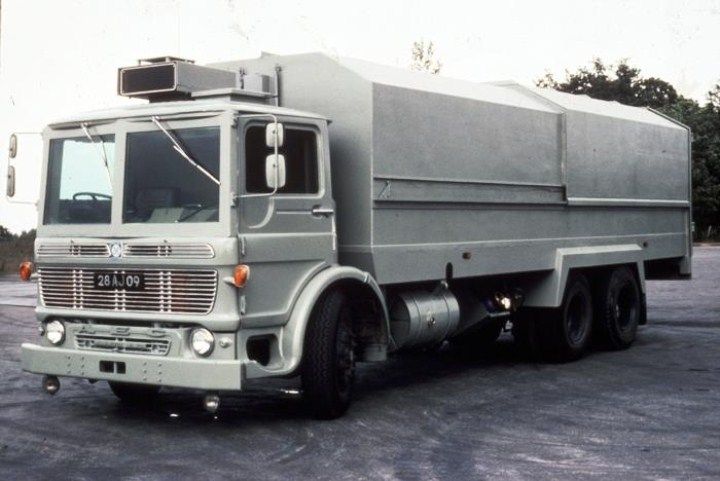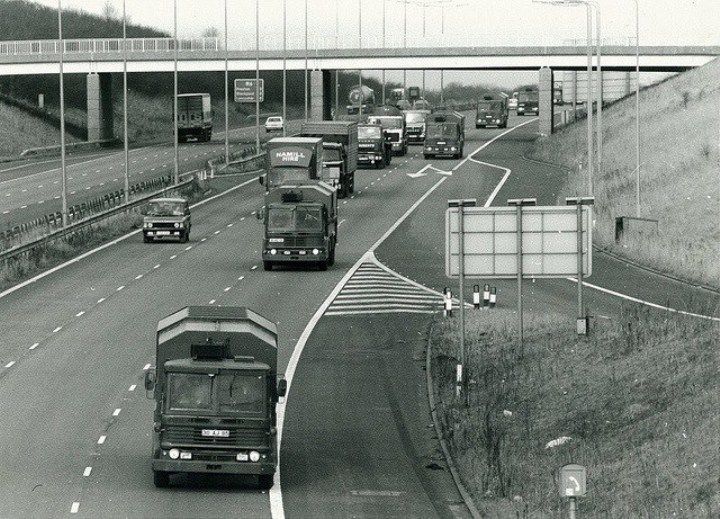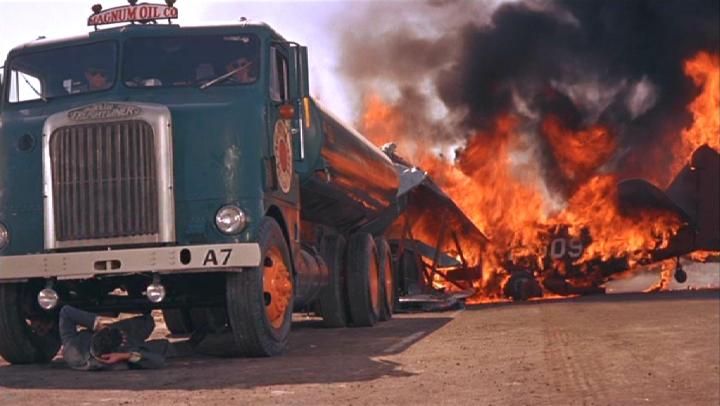Best Ergomatic Cabbed-Lorry Model? PART 3.Page 7.TRUCKNETUK
tiptop495:
Hey to everyone, Wasn’t the ergo not built for the britain market and the US cabovers for the US.
I think the US cabovers were over here not the most loved ( i speak out of Belgium and think for much of the European markets, a big cab yes but with no space,hard suspension not the say nothing,much less comfort,long turning circles,difficult to find parts whereas all were US designed,almost no dealers and so on. Only Mack could set through mostly on earthworks,and it was a beast to drive too even the long distance models.
The Yank was only for the fanatic over here. Most were only double drive ( not Mack )so expencive to maintain
Yes the Volvo was originally designed for the US,but was here accepted. because of reliability power,driving comfort and gearshifting.
But from cab design, I find the DAF’s 2600 (jukebox) had a much better look for Europe.It could have been a number one top selling truck if it had been equiped with a stronger and better engine as the P680 but with a ■■■■■■■■■■■ with lower fuel consumption for our standards. And a tipping cab.
But everyone his own preference,it’s only my opinion here.So you can discuss here for ever.
Cheers Eric,
AMERICAN HEAVY MOTOR TRUCKS.
Bearing in mind what I said in my previous posts in this thread,during the 1940s,1950s and for at least up to the mid 1960s,American heavy motor truck manufacturers probably produced the best heavy trucks and lorries in the world in terms of power,weight-saving,speed,cab design,durability and sustained long distance
heavy duty freight trunking. But,on the other hand,cab over engine heavy motor trucks had a somewhat harsh ride because of the forward set front axle,which in turn resulted in a poor turning circle.
Most of the American lorry makers fitted all steel welded and pressed steel cabs,while White-Freightliner
had aluminium cabs,but marques such as Peterbilt and Kenworth each designed their own welded aluminium
cabs later on,so these apparently were not as tough and rigid as the steel cabs.
However,steel cabs or no steel cabs,American lorry drivers had the luxuries of adjustable seats,heaters,
defrosters,air conditioning,armrests,radios,sound insulation,sleeper cabs,etc,etc.
I’ve remarked on this before,but Citizens Band Radio became big in America in the 1960s,and American
truck drivers could listen to music stations on their radios,or operate their CB Radios while trucking along the highways in their 200-400 BHP-plus Peterbilt,Kenworth,Freightliner,White,Mack,etc,cab over engine heavy motor trucks - courtesy of good sound insulation in their cabs! 
 At least some American COE heavy motor trucks built for export had normal mid-positioned steering axles
At least some American COE heavy motor trucks built for export had normal mid-positioned steering axles 
SCANDINAVIAN,EUROPEAN AND BRITISH HEAVY LORRIES.
Following closely behind the Americans were the Scandinavians,Europeans and,some distance behind these,
the British commercial vehicle manufacturers.
Then along came Volvo with it’s American inspired Volvo Titan TIPTOP 4951/4956/Volvo F88-F89 heavy lorry
models,BUT what Volvo did with the F88-F89 lorries was to take the best features of American heavy motor
trucks and produced more refined designs of these,which resulted in the F88 and F89 lorry models 
Other lorry manufactures went the Volvo way and produced American-inspired and refined heavy lorries,such as Scania,Mercedes-Benz and Berliet,and when these new designs were imported in to the United Kingdom,British lorry makers had to get their act together and come out with new lorry models that were greatly inspired by their Scandinavian and European rivals 
LEYLAND GROUP ERGOMATIC CAB.
The one thing that I did not like about the Ergomatic Cab was that it took away the external identity and
individuality of the AEC,Albion and Leyland commercial vehicle marques! 

 And by circa 1971 it was even worse!
And by circa 1971 it was even worse!  :The grand marque badges - AEC,Blue Triangle,Albion,Sure As The Sunrise and Leyland Shield had all been very misguidedly replaced with block letters on the Ergomatic cabs of these marques -
:The grand marque badges - AEC,Blue Triangle,Albion,Sure As The Sunrise and Leyland Shield had all been very misguidedly replaced with block letters on the Ergomatic cabs of these marques -
AEC,ALBION,LEYLAND 

 ,plus the AEC Yellowline (As Good As Gold) and Leyland Blueline
,plus the AEC Yellowline (As Good As Gold) and Leyland Blueline
identities and gold-yellow AEC and blue Leyland nameplates. Absolutely ridiculous,especially when that time
was one of growing competition from the likes of Volvo and co.
As for the merits and otherwise of the Ergomatic cab,it was more comfortable all round than a coachbuilt
cabbed AEC,or Atkinson,whatever,and was a mechanics dream for engine,clutch and gearbox “get-at-ability”.
So the the Leyland group Ergomatic Cab was definitely catching up with the likes of Volvo and Peterbilt! 

AEC 3VTG CONCEPT PROJECT LORRY.
As I said in my last post,the wise AEC 3VTG Concept Project Lorry was the wise and inspired idea of the boss of AEC,Dr.Albert D.Fogg,who obviously wanted to copy Volvo with it’s refined American-style F88-F89
lorry models,and produce a refined American-style AEC heavy lorry range  And in the words of the great
And in the words of the great
Barry Norman:“And why not”…  And why not indeed,because other lorry manufacturers were doing the same thing
And why not indeed,because other lorry manufacturers were doing the same thing 
The interior of the AEC 3VTG cab was well-appointed,with Bostrom Viking seats,a very comprehensive instrument panel and good cross cab access. The lorry’s engine bay allowed more air to circulate around
the engine than with the Ergomatic Cab,and it’s AEC 801 Series V8 engine had a much larger header tank,
radiator and cooling fan than the AEC Mandator V8.
Albert Fogg wanted to produce a better cab than the Ergomatic,and he was well on the way in doing this
with his AEC 3VTG Lorry  He realised that the Ergomatic was not big enough,it produced cooling problems
He realised that the Ergomatic was not big enough,it produced cooling problems
for the engines,especially in the tropics,it had design flaws and,according to Albert Fogg,it was not suitable
for long distance motorway journeys. So entered the AEC 3VTG Project-Concept-Prototype Heavy Lorry for all of the above reasons that I’ve listed 
But,as I’ve already stated,Leyland mismanagement very misguidedly scrapped the AEC 3VTG Programme  …and by doing so,it was yet another long,long,sharp,sharp nail in the unholy coffin of
…and by doing so,it was yet another long,long,sharp,sharp nail in the unholy coffin of
the British Leyland Motor Corporation! 

AMERICAN HEAVY MOTOR TRUCK ECLIPSE.
Considering Volvo,Scania,Mercedes-Benz,et al,began producing refined American-style heavy lorries from the mid to late 1960s-early 1970s,the Scandinavian,European - and even certain British at least - lorry manufactures surpassed the American heavy motor truck manufacturers,at least in regard to standard long
distance heavy duty freight trunking lorries  But these days,in 2013,since the world’s lorry and motor
But these days,in 2013,since the world’s lorry and motor
truck manufacturers have become more global,American,Scandinavian and European lorries and motor trucks are probably just as good as each other 
NUCLEAR WEAPONS TRANSPORTERS.
One of my favourite AEC Ergomatic lorries,in specialist form, are these:-
AEC Mammoth Major Six 760 TG6R Ergomatic long wheelbase 6x4 TCHD = Transport Cargo Heavy Duty TCHD Mk 1 Nuclear Weapons Transporter Lorries:-

In convoy…wonderfully fascinating,secretive and sinister  WOW!
WOW! 
 :-
:-

NORTH BY NORTHWEST WHITE FREIGHTLINER WF-64 BUBBLENOSE COE HEAVY MOTOR TRUCK.
And keeping with somewhat delightfully sinister activities,such as spies,nuclear weapons,etc,here is a still
photograph from one of my favourite spy films - and Alfred Hitchcock films as well - NORTH BY NORTHWEST,the climax of the famous aeroplane cropduster scene:-This aeroplane crashes in to a magnificent White Freightliner WF-64 Bubblenose COE Tanker-bodied 6x4 Drawbar Trailer Outfit,of Magnum Oil Co,and Cary Grant - Roger Thornhill - is crawling from underneath the front end of this lorry - one of the ancestors of the Volvo F88-F89 heavy lorry models  :-
:-

Exciting! 

VALKYRIE
Second choice would be a Mercury, so the same but with an axle missing, third would be a Leyland Beaver, same colours, but maybe pulling a cylindrical stainless steel tanker, I prefer the narrower front mudguards on the Beaver over the wider ones on the Mandator, so that would be the only reason it would be preferable to teh Southall built model, well unless I could find a V8 Mandator and then all bets are off, that would be number one, two and three on my list
![]() Especially when you could probably order a Crusader with the AEC V8 in it if you really didn’t want a Detroit or a Rolls in it instead.
Especially when you could probably order a Crusader with the AEC V8 in it if you really didn’t want a Detroit or a Rolls in it instead. ![]()
![]()




